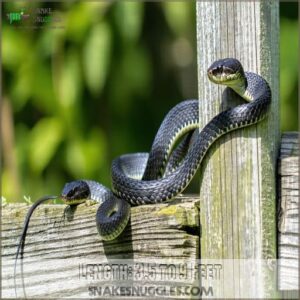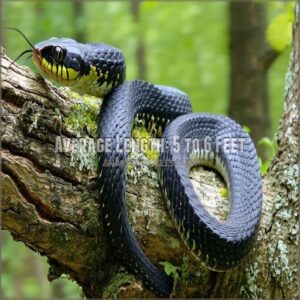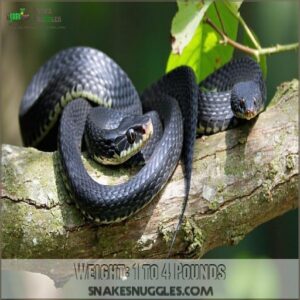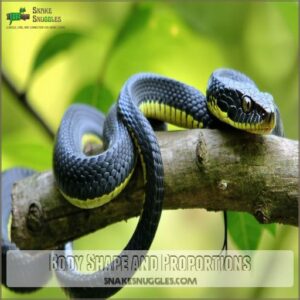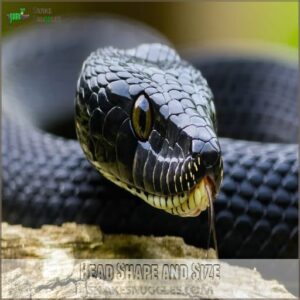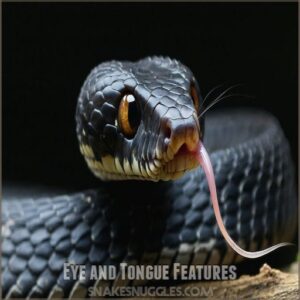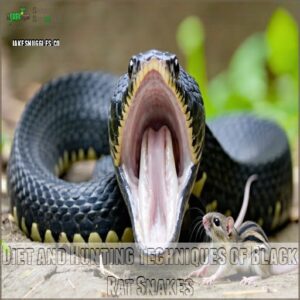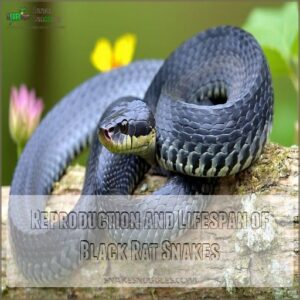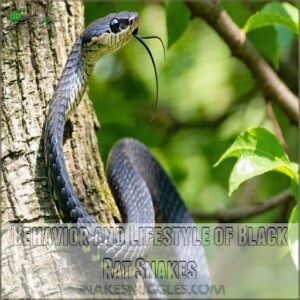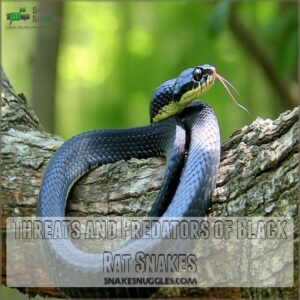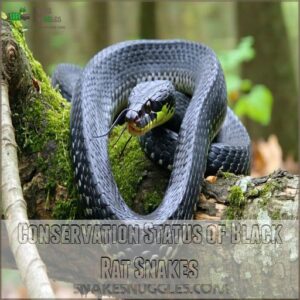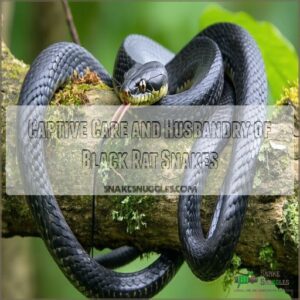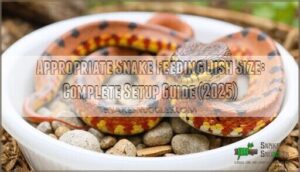This site is supported by our readers. We may earn a commission, at no cost to you, if you purchase through links.
 You’ll find that black rat snakes are impressive creatures that can stretch between 3.5 and 7 feet long, with some exceptional individuals reaching up to 8 feet.
You’ll find that black rat snakes are impressive creatures that can stretch between 3.5 and 7 feet long, with some exceptional individuals reaching up to 8 feet.
That’s taller than your average doorway!
These non-venomous giants typically weigh between 1 and 4 pounds when fully grown.
Males tend to be larger than females, and their size often depends on factors like diet, habitat quality, and genetics.
While they might sound intimidating, these gentle giants are actually beneficial neighbors, keeping rodent populations in check.
Their remarkable climbing abilities and hunting strategies make their size even more fascinating.
Table Of Contents
- Key Takeaways
- How Big Do Black Rat Snakes Get?
- Black Rat Snake Size Range
- Physical Characteristics of Black Rat Snakes
- Habitat and Distribution of Black Rat Snakes
- Diet and Hunting Techniques of Black Rat Snakes
- Reproduction and Lifespan of Black Rat Snakes
- Behavior and Lifestyle of Black Rat Snakes
- Threats and Predators of Black Rat Snakes
- Conservation Status of Black Rat Snakes
- Captive Care and Husbandry of Black Rat Snakes
- Frequently Asked Questions (FAQs)
- What does a black rat snake look like?
- What does an eastern rat snake look like?
- How long is a rat snake?
- How much does a rat snake weigh?
- How long do black rat snakes live?
- What does a black snake look like?
- Is a black rat snake aggressive?
- Do black rat snakes keep other snakes away?
- What is the largest black rat snake ever recorded?
- How can you tell a black snake from a rat snake?
- How fast do juvenile black rat snakes grow?
- Whats the largest recorded wild black rat snake?
- Do male and female black rat snakes differ?
- When do black rat snakes reach full size?
- Can environmental factors affect their maximum size?
- Conclusion
Key Takeaways
- You’ll find adult black rat snakes typically measure between 3.5 to 7 feet long, though exceptional specimens can reach up to 9 feet in length
- While females tend to be slightly larger, these non-venomous snakes typically weigh between 1 and 4 pounds at maturity
- You’ll see most rapid growth in their first three years, with juveniles adding 2-3 feet annually until reaching full size at age four
- Your location matters – southern populations generally grow larger than northern ones due to longer growing seasons and more abundant food sources
How Big Do Black Rat Snakes Get?
You’ll find that black rat snakes can grow impressively long, reaching lengths between 3.5 and 9 feet in their adult years.
These non-venomous snakes typically measure around 5 to 6 feet long, making them one of the largest snake species you’ll encounter in North America.
Average Length and Weight of Black Rat Snakes
Ever wondered about the typical size of a black rat snake? These remarkable reptiles have a consistent average length range that might surprise you.
Most black rat snakes you’ll encounter measure:
- Between 3.5 to 6 feet in length – about the height of your front door
- Around 2-3 pounds at maturity – similar to a house cat
- Body width of 1-2 inches – think garden hose diameter
- Females slightly larger than males in general
These measurements represent typical adult specimens you’d find in the wild, though factors like diet and habitat can influence their size.
Maximum Length and Weight of Black Rat Snakes
You’ll be amazed to discover that black rat snakes can reach extraordinary lengths of up to nine feet, though such giants are rare.
These impressive serpents typically max out at seven feet when fully grown, with the largest verified specimen weighing in at 4 pounds.
While most you’ll encounter won’t reach these extremes, they’re still among the longest snakes in North America.
Factors Affecting Growth in Black Rat Snakes
Several factors shape a black rat snake’s growth potential. Food availability directly impacts their size – well-fed snakes grow larger and faster.
Climate conditions play a key role too, with warmer temperatures speeding up metabolism.
Genetic factors set natural size limits, while age influences growth rates.
In competitive environments, these snakes might grow more slowly due to limited resources and increased stress.
Comparison With Other Snake Species
When comparing black rat snakes to other species, they’re among the largest non-venomous snakes in North America.
While corn snakes typically reach 4-5 feet, and copperheads max out at 3 feet, black rat snakes can grow to an impressive 9 feet.
They share similar habitats with timber rattlesnakes and copperheads, though they’re much longer and more slender than these venomous cousins.
Black Rat Snake Size Range
You’ll find black rat snakes ranging from a modest 3.5 feet to an impressive 9 feet in length, making them one of North America’s longest native snakes.
While most adults you’ll encounter measure between 5 to 6 feet long, these remarkable reptiles can weigh anywhere from 1 to 4 pounds at full size.
Length: 3.5 to 9 Feet
Black rat snakes showcase remarkable size variation, ranging from 3.5 feet up to an impressive 9 feet in length.
They’re among the longest snakes you’ll encounter in North America, with females typically growing larger than males.
Here’s what influences their size potential:
- Genetics play a major role in determining maximum length
- Abundant prey, as discussed in factors affecting snake growth, is essential for meeting nutritional needs, and Food availability affects growth rate and final size
- Regional climate impacts overall development
- Habitat quality directly influences growth potential
Average Length: 5 to 6 Feet
Throughout their adult lives, most black rat snakes you’ll encounter measure between 5 to 6 feet in length.
Let’s break down their typical measurements across different regions:
| Region | Male Length | Female Length |
|---|---|---|
| Northern | 5.2 feet | 5.5 feet |
| Central | 5.4 feet | 5.7 feet |
| Southern | 5.6 feet | 5.9 feet |
You’ll notice females tend to be slightly longer than males, with southern populations generally reaching greater lengths due to longer growing seasons.
Weight: 1 to 4 Pounds
Despite their impressive length, you’ll find that black rat snakes are surprisingly light, weighing between 1 to 4 pounds at maturity.
Adult females typically weigh more than males, especially during breeding season when they’re carrying eggs.
Their slender build helps them stay agile while climbing trees and moving through tight spaces in search of prey.
Physical Characteristics of Black Rat Snakes
You’ll notice that black rat snakes have a distinctive appearance with their shiny black scales and slender bodies that can stretch up to nine feet in length.
Their elongated heads feature sharp eyesight and a flickering tongue that helps them navigate their environment, while their smooth skin allows them to move easily through various terrains.
Body Shape and Proportions
The powerful body of a black rat snake is a masterpiece of natural design – slender yet muscular, built for both strength and agility.
You’ll notice their body maintains a consistent thickness throughout, unlike some snakes that taper dramatically.
They’re remarkably slim for their length, with a body diameter typically around 1-2 inches, making them perfectly adapted for climbing trees and moving through tight spaces.
Head Shape and Size
Most black rat snakes have an elongated, triangular-shaped head that’s slightly wider than their neck, perfect for swallowing larger prey whole.
You’ll notice their head is relatively small compared to their body size, but don’t let that fool you – it’s incredibly flexible.
Their jaw can unhinge, allowing them to consume prey up to 1.5 times the width of their head.
Eye and Tongue Features
Along with impressive size, black rat snakes possess keen eyesight and a remarkable forked tongue that work together as sophisticated navigation tools. You’ll notice their large, round eyes provide excellent vision for hunting, while their tongue constantly flicks to sample air particles.
Here’s what makes their sensory system special:
- Bifurcated tongue processes chemical signals from prey
- Forward-facing eyes enable precise depth perception
- Pupils dilate widely for enhanced night vision
Scale Patterns and Coloration
You’ll notice these snakes sport shiny black scales across their back, creating a sleek, polished appearance.
Their belly scales are light-colored, often white or cream, with a distinctive white throat and chin.
While most specimens display this classic coloration, some show interesting variations, including hints of gray or brown.
Their flexible scales, which enable remarkable climbing ability, are a sign of their adaptability.
Their smooth scales aren’t just for looks – they help these snakes glide effortlessly through their environment.
Habitat and Distribution of Black Rat Snakes
You’ll find these impressive reptiles making themselves at home across eastern and central North America, from the dense forests of southern Canada to the sunny grasslands of northern Mexico.
Black rat snakes thrive in places with plenty of cover and food sources.
Whether they’re coiled up in fallen logs, basking on forest edges, or slithering through marshlands, black rat snakes thrive in places with plenty of cover and food sources.
Preferred Environments: Forests, Grasslands, and Marshes
Black rat snakes thrive in diverse environments where they can find both shelter and sustenance.
These adaptable creatures make themselves at home in:
- Dense forests with fallen logs and thick undergrowth
- Grassy meadows dotted with rocks and burrows
- Marshy wetlands rich in prey species
You’ll often spot them basking on sun-warmed rocks or slithering through leaf litter, making the most of natural cover while hunting their next meal.
Geographic Range: Eastern and Central North America
In the vast expanse of North America, these remarkable serpents have carved out a territory stretching from southern Ontario to northern Florida.
You’ll find them slithering through the eastern states, from Connecticut to Wisconsin, and as far west as Texas.
Their range overlaps with various ecosystems, adapting to both warm southern climates and cooler northern regions, making them one of the most widespread native snakes.
Habitat Features: Cover, Food Sources, and Shelter
Moving beyond North America, let’s explore where these fascinating creatures make their homes.
Within their range, black rat snakes thrive in environments that offer three key features:
- Dense vegetation and fallen logs for protection from predators
- Abundant prey populations, including mice, rats, and birds
- Safe spaces like rock crevices and hollow trees for hibernation during cold months
These habitat features support healthy populations and allow them to reach impressive sizes.
Diet and Hunting Techniques of Black Rat Snakes
You’ll find these impressive hunters using stealth and quick strikes to catch their favorite meals of small mammals, birds, and lizards.
Thanks to their ability to unhinge their jaws, they can swallow prey much larger than their own head, making them highly efficient predators in their environment.
Prey Species: Small Mammals, Birds, and Lizards
You’ll find these skilled predators chowing down on an impressive menu of small mammals, from mice to chipmunks, which are some of the primary mammalian prey selection for black rat snakes when controlling rodent populations as opportunistic predators.
Black rat snakes don’t stop there – they’re happy to feast on birds, their eggs, and even lizards when the opportunity strikes.
Their diverse diet makes them nature’s perfect pest control, which is why farmers often welcome these adaptable hunters on their properties.
Hunting Techniques: Stealth, Ambush, and Swift Strikes
Black rat snakes are masters of the surprise attack.
Like skilled ninjas, they’ll use their dark coloring to blend into shadows before striking at lightning speed.
They’ve got two main tricks up their sleeve: either waiting motionless to ambush passing prey, or actively stalking their target with smooth, calculated movements.
When they’re ready to strike, these snakes can launch forward with impressive accuracy and power.
Feeding Habits: Frequency and Quantity
Surprisingly, a black rat snake’s appetite matches its impressive size.
You’ll find these skilled hunters consuming meals that can weigh up to 25% of their body mass.
They typically feed every 7-14 days, depending on prey size and seasonal conditions.
When temperatures drop below 60°F, they’ll reduce their feeding frequency, sometimes going months without eating during winter brumation.
Reproduction and Lifespan of Black Rat Snakes
You’ll be amazed to learn that black rat snakes start their journey with complex mating rituals, where males compete for females before the females store sperm for future egg-laying.
Once the eggs are laid in decaying vegetation or underground burrows, they’ll take about 60 days to hatch, and these remarkable snakes can live up to 15 years in the wild.
Mating Rituals and Breeding Season
During spring’s warm embrace, black rat snakes begin their intricate mating dance.
Males compete for females through ritualistic combat, intertwining their bodies in a graceful wrestling match that can last several hours.
The female’s choice of mate isn’t just about strength – she’ll select a partner based on size, stamina, and persistent courtship displays.
Once mating occurs, she’ll store the sperm until conditions are perfect.
Egg Laying and Incubation Period
The female’s egg-laying process marks a significant phase in the black rat snake’s reproductive cycle. She’ll find a cozy spot in decaying vegetation or an underground burrow to lay her clutch. The incubation period typically spans 60 days, during which the eggs require specific conditions to develop properly.
- Females lay 6-24 eggs per clutch
- Ideal incubation temperature ranges from 82-85°F
- Eggs need 65-75% humidity levels
- Nesting sites often include rotting logs or compost piles
Hatchling Development and Growth Rate
Baby black rat snakes start their journey at just 10-12 inches long.
When shopping for enclosures, you’ll want to think about black rat snake size to accommodate their rapid growth.
You’ll notice they grow rapidly in their first two years, adding about 2-3 feet to their length annually when food’s plentiful.
Growth rates depend heavily on diet quality and environmental conditions.
They’ll reach sexual maturity between 3-4 years old, by which time they’ve typically grown to 3-4 feet in length.
Average Lifespan in The Wild: 15 Years
You might be surprised to learn that wild black rat snakes typically live around 15 years, though this can vary based on environmental conditions and predator presence.
Their survival depends heavily on habitat quality, food availability, and their ability to avoid threats like vehicles and larger predators.
In captivity, they often exceed this lifespan, with some individuals reaching 20-25 years under excellent care conditions.
Factors such as genetics, nutrition, and housing, which can greatly impact a snake’s longevity, as discussed in the context of corn snake lifespan.
Behavior and Lifestyle of Black Rat Snakes
You’ll find black rat snakes most active during daylight hours, when they’re either basking in the sun to warm up or hunting for their next meal.
While they’re typically shy and prefer to avoid confrontation, these skilled climbers will spend their days searching for food across various environments, from forest floors to farmlands.
Daily Life and Habits: Diurnal, Solitary, and Social Behavior
Black rat snakes lead fascinating daily lives that’ll keep you guessing.
These impressive creatures follow predictable patterns, staying active during daylight hours when they’re hunting or exploring their territory.
While they’re typically loners, you’ll sometimes spot them sharing space during breeding season or winter hibernation.
- Silently gliding through forest undergrowth, masters of stealth
- Moving with purpose and precision as they track prey
- Investigating every nook and cranny of their domain
- Displaying remarkable patience when stalking potential meals
- Exploring complex environments with graceful determination
Basking and Thermoregulation: Sun Exposure and Shelter
During the early morning hours, these fascinating creatures emerge to bask in patches of sunlight, a key behavior for maintaining their body temperature.
Here’s a breakdown of their thermoregulation patterns:
| Time of Day | Basking Location | Temperature Range |
|---|---|---|
| Morning | Open clearings | 70-75°F |
| Midday | Partial shade | 80-85°F |
| Afternoon | Rock crevices | 75-80°F |
| Evening | Forest floor | 65-70°F |
These temperature-seeking behaviors help black rat snakes maintain sufficient energy levels for hunting and digestion.
Communication and Interaction: Visual and Chemical Signals
In terms of communication, these impressive serpents rely on a sophisticated combination of body language and chemical signals, including the use of pheromones for mating.
You’ll notice them flicking their tongues to "taste" the air, picking up scents from other snakes and potential prey.
Their body movements tell quite a story too – from defensive postures when threatened to subtle visual cues during mating season.
They’re constantly sharing information through scent marking.
Threats and Predators of Black Rat Snakes
You’ll find that black rat snakes face threats from natural predators like mink, large carnivores, and birds of prey that hunt them in their native habitats.
Black rat snakes can grow up to nine feet long, but they’re also vulnerable to human activities, including getting hit by cars when crossing roads and losing their homes due to habitat destruction.
Natural Predators: Mink, Large Carnivores, and Birds of Prey
Despite their impressive size, black rat snakes face numerous predators in the wild. You’ll find these adaptable creatures constantly watching for threats from above and below. They’re a favorite meal for many predators across their range, including specialized snake hunters like mongooses and meerkats that possess venom resistance.
- Hawks dive from above with deadly precision
- Owls strike silently in the night
- Minks track them through water and land
- Coyotes and foxes hunt them opportunistically
- Large wild cats stalk them through undergrowth
Habitat Destruction and Fragmentation
Habitat loss poses a critical threat to black rat snake populations, with their once-vast territories now split into isolated patches.
Let’s explore the key impacts and solutions:
| Impact | Conservation Solution |
|---|---|
| Forest clearing | Protected area networks |
| Urban sprawl | Wildlife corridors |
| Agricultural expansion | Habitat restoration |
| Infrastructure development | Land use planning |
| Resource extraction | Conservation easements |
You’ll find these magnificent creatures increasingly confined to smaller areas as development fragments their natural range.
Human Activities: Vehicle Strikes and Poisoning
Beyond habitat changes, you’ll find these magnificent snakes facing serious threats from cars and chemicals.
Black rat snakes often cross roads or bask on warm pavement, making them vulnerable to vehicle strikes.
They’re also accidentally poisoned when people use pest control methods targeting rodents.
Understanding their size – up to 9 feet long – helps drivers spot and avoid these beneficial predators on roads.
Conservation Status of Black Rat Snakes
You’ll be relieved to know that black rat snakes aren’t endangered, though they face challenges from habitat loss and road accidents.
Black rat snakes continue to thrive across their range in North America.
You can help protect them by supporting local conservation efforts and being careful when driving through their natural habitats.
Threats and Conservation Efforts
Black rat snakes face mounting challenges in today’s world.
You’ll find these impressive creatures battling against road mortality, particularly during their active seasons.
Climate change is altering their traditional habitats, while pesticide use affects both them and their prey.
Invasive species compete for resources, making survival harder for these beneficial predators.
Conservation efforts focus on identifying and addressing these threats through monitoring programs and public education initiatives.
Habitat Protection and Restoration
Protecting these remarkable snakes starts with preserving their natural homes.
Well-planned forest restoration and land management create safe spaces where black rat snakes can thrive.
Here’s what’s working to keep their populations stable:
- Creating wildlife corridors that connect fragmented habitats
- Restoring native vegetation in degraded areas
- Implementing sustainable forestry practices
- Preserving old-growth trees and fallen logs for shelter
Education and Public Awareness
Through educational programs across North America, you’ll learn that these impressive snakes aren’t the villains they’re often made out to be.
Many organizations now offer hands-on demonstrations to help dispel common snake myths, often highlighting that some popular pet snakes, such as non-venomous corn snakes, are generally docile and harmless to humans, and reduce venomous confusion.
You’ll discover safe handling advice and appreciate their important role in ecosystem balance.
Conservation efforts focus on teaching communities about black rat snake size, behavior, and their beneficial pest control services.
Research and Monitoring Programs
Scientists are making great strides in understanding black rat snake populations across North America.
Research teams track these impressive serpents using three main approaches:
- Population surveys using radio telemetry to map movement patterns
- DNA analysis to measure genetic diversity between different regions
- Health monitoring to detect emerging diseases that could affect snake sizes, and also recommending products that support black rat snake growth and care check black rat snake growth products.
This data helps protect these beneficial predators for future generations.
Captive Care and Husbandry of Black Rat Snakes
Keeping a black rat snake as a pet requires careful attention to their size and specific needs.
You’ll need a secure enclosure that’s at least 4 feet long for adults, given their impressive growth potential of up to 7 feet. Consider investing in a high-quality rat snake enclosure from a reputable supplier like Everysimply Chewy Rat Snake Enclosures to provide a safe and comfortable environment.
Maintain temperatures between 75-85°F with a basking spot of 90°F, and humidity around 60%.
Feed your snake appropriately sized mice or rats every 7-14 days, adjusting portions as they grow.
Handle your snake gently but regularly to build trust, starting with short sessions, by first allowing a two-week adjustment period to acclimate to its new environment as described in safe handling tips for new snakes. Watch for signs of health issues like respiratory infections or retained shed. Snakes often display unusual posturing or resting positions, such as head tilting signs, which could be due to stress or lack of hydration.
Provide fresh water daily and clean the enclosure weekly.
Include climbing branches and hiding spots to mimic their natural habitat.
With proper care, these fascinating creatures can live 15-20 years in captivity, making them long-term companions.
Frequently Asked Questions (FAQs)
What does a black rat snake look like?
Like a sleek black sports car, you’ll recognize a black rat snake by its glossy black scales, slender body, and light-colored belly.
They’ve got smooth skin, keen eyes, and a flickering tongue for navigation.
What does an eastern rat snake look like?
You’ll spot an eastern rat snake by its distinctive shiny black scales covering its back and a light-colored underbelly. Regular monitoring for Snake Fungal Disease symptoms can help you catch potential skin infections early.
These non-venomous snakes stand out with their bright white throat and chin.
How long is a rat snake?
Size isn’t everything, but in terms of rat snakes, you’ll find they’re impressive. These non-venomous serpents typically stretch between 3 to 7 feet long, with some exceptional specimens reaching up to 9 feet.
How much does a rat snake weigh?
Adult black rat snakes typically weigh between 5 to 3 pounds, with females being slightly heavier. You’ll notice their weight varies based on their recent meals and the season’s feeding patterns.
How long do black rat snakes live?
While 94% of wild black rat snakes survive their first year, they’ll typically live around 15 years in their natural habitat.
With proper care and protection from predators, you’ll find they can thrive longer.
What does a black snake look like?
You’ll spot black rat snakes by their shiny black scales with hints of gray or brown.
They’ve got slender bodies, a white throat and chin, and a light-colored belly that helps them glide smoothly.
Is a black rat snake aggressive?
Like a gentle giant in your garden, black rat snakes aren’t aggressive – they’re actually quite shy.
You’ll find they prefer to retreat when startled, though they might strike defensively if you don’t give them space.
Do black rat snakes keep other snakes away?
Despite popular belief, black rat snakes don’t actively keep other snakes away.
They’ll actually share winter dens with different species, including copperheads and rattlesnakes, though they’re generally peaceful neighbors in these shared spaces.
What is the largest black rat snake ever recorded?
According to Missouri Department of Conservation records, the largest officially documented black rat snake was 84 inches (7 feet) long. However, trustworthy specimens reaching 8’5" have been reliably reported.
How can you tell a black snake from a rat snake?
While these snakes look similar, you’ll notice black snakes have a bluish-black sheen with white chins, while rat snakes display duller black scales and may show faint patterns underneath.
Their head shapes also differ slightly.
How fast do juvenile black rat snakes grow?
Juvenile black rat snakes grow rapidly in their first year, reaching 20-30 inches. You’ll notice they can add 2-3 feet annually until maturity, with growth slowing after age three.
Whats the largest recorded wild black rat snake?
The largest recorded wild black rat snake measured an impressive 76 feet long, found in Maryland in You’ll be amazed to know that’s almost twice the size of a typical adult!
Do male and female black rat snakes differ?
Birds of a feather don’t flock together in the case of black rat snakes – you’ll notice females are typically larger and heavier than males.
They’ll differ in size, but share similar coloring and patterns.
When do black rat snakes reach full size?
Growing steadily over their first three years, black rat snakes are similar in size to Eastern Ratsnakes in Florida, which can grow up to 42 to 72 inches in length, according to a guide to Florida rat snakes species. black rat snakes typically reach their full adult size by age four.
You’ll notice they can grow up to six feet long, with some exceptional specimens hitting nine feet.
Can environmental factors affect their maximum size?
Factors like food availability, habitat quality, and climate can influence your black rat snake’s maximum size.
They’ll grow larger with abundant prey and ideal temperatures,
while resource-poor environments may limit their growth potential.
Conclusion
You’ve discovered that black rat snakes get surprisingly massive, reaching lengths that’ll make your jaw drop!
These gentle giants typically stretch 3.5 to 7 feet long, with some exceptional specimens hitting the 8-foot mark.
While knowing how big black rat snakes get might seem intimidating, remember they’re nature’s pest control experts, keeping your property rodent-free.
So next time you spot one of these impressive creatures, give them space and appreciate their important role in maintaining ecological balance.

